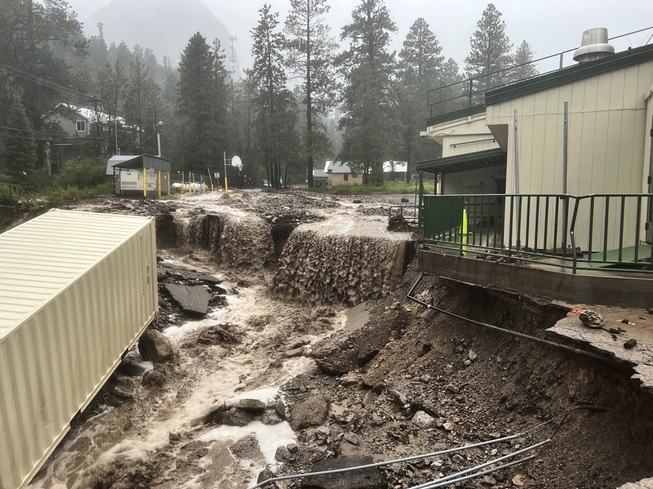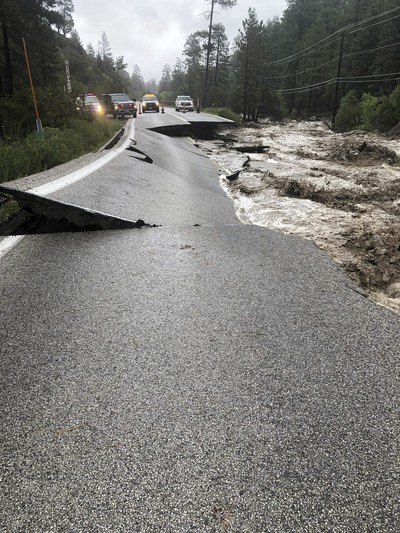
Firefighter Jason Douglas / Clark County Public Information Office via AP
This image provided by the Clark County, Nev., Public Information Office shows flood damage, Monday, Aug. 21, 2023, outside Lundy Elementary School in the Old Town section of Mount Charleston near Las Vegas.
Published Monday, Aug. 21, 2023 | 8:43 a.m.
Updated Monday, Aug. 21, 2023 | 7:31 p.m.
CATHEDRAL CITY, Calif. — Hilary, the first tropical storm to hit Southern California in 84 years, flooded roads, toppled trees and forced a rescue by bulldozer of more than a dozen older residents trapped by mud in a care home Monday as it marched northward, prompting flood watches and warnings in half a dozen states.
As Hilary moved east into the neighboring state of Nevada, flooding was reported, power was out and a boil-water order was issued for about 400 households in the Mount Charleston area, where the only road in and out was washed out. The area is about 40 miles (64 kilometers) west of Las Vegas.
The National Hurricane Center in Miami said Hilary had lost much of its steam and only vestiges of the storm were heading over the Rocky Mountains, but it warned that “continued life-threatening and locally catastrophic flooding” was expected over portions of the southwestern U.S., following record-breaking rainfall. Forecasters said the threat for flooding in states farther north on Monday was highest across much of southeastern Oregon into the west-central mountains of Idaho, with potential thunderstorms and localized torrential rains on Tuesday.
Hilary first slammed into Mexico’s arid Baja California Peninsula as a hurricane, causing one death and widespread flooding before becoming a tropical storm, one of several potentially catastrophic natural events affecting California on Sunday. Besides the tropical storm, which produced tornado warnings, there were wildfires and a moderate earthquake north of Los Angeles. So far, no deaths, serious injuries or extreme damages have been reported in the state, though officials warned that risks remain, especially in the mountainous regions where the wet hillsides could unleash mudslides.
In one dramatic scene, rescue officials in the desert community of Cathedral City, near Palm Springs, drove a bulldozer through mud to the swamped care home and rescued 14 residents by scooping them up and carrying them to safety, Fire Chief Michael Contreras said. They were among 46 rescues the city performed between late Sunday night and the next afternoon from mud and water standing up to 5 feet (1.5 meters.)
“We were able to put the patients into the scoop. It’s not something that I’ve ever done in my 34 years as a firefighter, but disasters like this really cause us to have to look at those means of rescue that aren’t in the book and that we don’t do everyday," he said at a news conference.
San Bernardino County first responders also were continuing to rescue some 30 people who became stranded when the Santa Ana River overflowed near the community of Seven Oaks. Authorities said boulders in the flow made it too dangerous to send boats so the people stayed overnight.
On Monday, a helicopter rescued one person with a leg injury and efforts to retrieve the others were expected to continue into Tuesday morning, although some people refused to fly out and wanted to wait for the floodwaters to recede, authorities said.
To the northwest in the San Bernardino Mountains, crews worked to clear mud that blocked the homes of about 800 residents, said Cal Fire Battalion Chief Alison Hesterly. In the mountain community of Oak Glen, Brooke Horspool helped dig out a home surrounded by about 4 feet (1.2 meters) of mud to free a couple, including an older man with medical issues.
Amid the storm Sunday in Palm Desert, Terry Flanigan heard a huge crash and then got a text from a neighbor that a Eucalyptus tree, more than 100 feet (30 meters) tall, fell onto a condo across the street. She later learned it landed on the bed of her neighbor’s 11-year-old son, who luckily was in another room.
“It was very unnerving,” Flanigan said, adding that the family had gone to stay with relatives while removal crews came Monday morning to remove the branches. “Oh my gosh, what could have happened.”
Hilary is just the latest major weather event to wreak havoc across the U.S., Canada and Mexico. Hawaii’s island of Maui is still reeling from a blaze that killed more than 100 people, making it the deadliest U.S. wildfire in more than a century. Firefighters in Canada are battling that nation’s worst fire season on record.
Hot water and hot air were both crucial factors that enabled Hilary's rapid growth — steering it on an unusual but not quite unprecedented path that dumped rain in some normally bone-dry places.
It shattered daily rain totals in places and likely dumped the equivalent of a full year's worth on Death Valley National Park, forcing the park to be closed indefinitely and leaving about 400 people sheltering at Furnace Creek, Stovepipe Wells and Panamint Springs until roads could be made passable, park officials said.
Rain came in two bursts on Sunday — in the morning and evening — totaling 2.2 inches (5.6 centimeters) at a National Weather Service rain gauge at Furnace Creek. If verified, it would be the single-rainiest day in the area's history, beating its record of 1.7 inches (4.3 centimeters) set Aug. 5, 2022.
Park officials responded Monday to sewer line damage releasing raw sewage into the desert below Stovepipe Wells.
Sunday was the wettest day on record in San Diego with 1.82 inches (4.6 centimeters), the NWS said in a post on X, formerly known as Twitter. The previous record was on Aug. 17, 1977, when 1.8 inches (4.5 centimeters) of rain fell in the area post-Hurricane Doreen.
“We basically blew all of our previous rainfall records out of the water,” National Weather Service meteorologist Elizabeth Adams in San Diego told The Associated Press.
Scientists still don’t know why some storms, like Hilary, get big and some stay small, said MIT hurricane scientist Kerry Emanuel.
“It’s quite unusual for an Eastern Pacific storm to be so large since they are usually small and stay deep in the tropics,” said University of Albany atmospheric scientist Kristen Corbosiero, an expert on Pacific hurricanes.
The wet weather might stave off wildfires for a few weeks in Southern California and in parts of the Sierra Nevada but widespread rain is not expected in the most fire-prone areas, University of California, Los Angeles, climate scientist Daniel Swain said in an online briefing Monday.
In the Coachella Valley city of Desert Hot Springs, Steven Michael Chacon said the roads in the housing development where he and his husband live were impassable due to flooding and he was concerned emergency crews might not be able to reach people.
“Basically everybody’s got to stay put, there’s no way in or out,” he said Monday morning.
The center of Hilary passed over downtown Los Angeles at 7 p.m. Sunday, according to the regional weather office, which called it “a day for the ages” in Southern California.
“Los Angeles was tested but we came through it, and we came through it with minimal impacts considering what we endured,” City Council President Paul Krekorian said.
A tropical storm last roared into California in September 1939, ripping apart train tracks, tearing houses from their foundations and capsizing many boats. Nearly 100 people were killed on land and at sea.
In the Caribbean, meanwhile, Tropical Storm Franklin churned on Monday near Haiti and the Dominican Republic, while forecasters at the National Hurricane Center said another storm could develop and reach the Gulf of Mexico coastline on Tuesday.
___
Antczak and Stefanie Dazio reported from Los Angeles and Watson from San Diego. Associated Press reporters Eugene Garcia in Cathedral City; Ken Ritter in Las Vegas; Will Weissert in Washington; Freida Frisaro in Fort Lauderdale, Florida; Curt Anderson in St. Petersburg, Florida; and Walter Berry in Phoenix, contributed to this report.
Las Vegas Sun Managing Editor Ray Brewer and Associated Press reporters Christopher Weber, Damian Dovarganes and Jordi Lebrija contributed to this report.

